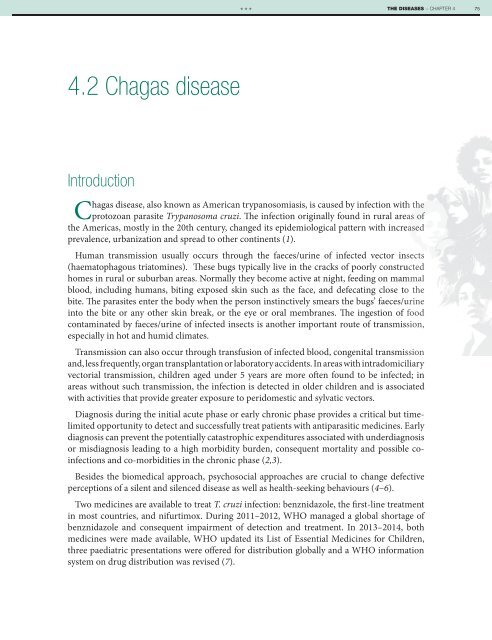1A9bnbK
1A9bnbK
1A9bnbK
Create successful ePaper yourself
Turn your PDF publications into a flip-book with our unique Google optimized e-Paper software.
***<br />
THE DISEASES − CHAPTER 4<br />
75<br />
4.2 Chagas disease<br />
Introduction<br />
Chagas disease, also known as American trypanosomiasis, is caused by infection with the<br />
protozoan parasite Trypanosoma cruzi. The infection originally found in rural areas as of<br />
the Americas, mostly in the 20th century, changed its epidemiological pattern with increased<br />
prevalence, urbanization and spread to other continents (1).<br />
Human transmission usually occurs through the faeces/urine of infected vector insects<br />
(haematophagous triatomines). These bugs typically live in the cracks of poorly constructed<br />
homes in rural or suburban areas. Normally they become active at night, feeding on mammal mmal<br />
blood, including humans, biting exposed skin such as the face, and defecating close to the<br />
bite. The parasites enter the body when the person instinctively smears the bugs’ faeces/urine<br />
into the bite or any other skin break, or the eye or oral membranes. The ingestion of food<br />
contaminated by faeces/urine of infected insects is another important route of transmission, sion,<br />
especially in hot and humid climates.<br />
Transmission can also occur through transfusion of infected blood, congenital transmission ssion<br />
and, less frequently, organ transplantation or laboratory accidents. In areas with intradomiciliary<br />
vectorial transmission, children aged under 5 years are more often found to be infected; in<br />
areas without such transmission, the infection is detected in older children and is associated<br />
with activities that provide greater exposure to peridomestic and sylvatic vectors.<br />
Diagnosis during the initial acute phase or early chronic phase provides a critical but timelimited<br />
opportunity to detect and successfully treat patients with antiparasitic medicines. Early<br />
diagnosis can prevent the potentially catastrophic expenditures associated with underdiagnosis<br />
or misdiagnosis leading to a high morbidity burden, consequent mortality and possible coinfections<br />
and co-morbidities in the chronic phase (2,3).<br />
Besides the biomedical approach, psychosocial approaches are crucial to change defective<br />
perceptions of a silent and silenced disease as well as health-seeking behaviours (4–6).<br />
Two medicines are available to treat T. cruzi infection: benznidazole, the first-line treatment<br />
in most countries, and nifurtimox. During 2011–2012, WHO managed a global shortage of<br />
benznidazole and consequent impairment of detection and treatment. In 2013–2014, both<br />
medicines were made available, WHO updated its List of Essential Medicines for Children,<br />
three paediatric presentations were offered for distribution globally and a WHO information<br />
system on drug distribution was revised (7).


